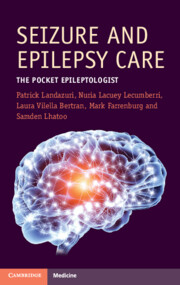Book contents
- Seizure and Epilepsy Care
- Seizure and Epilepsy Care
- Copyright page
- Contents
- 1 How Do I Evaluate a First-Time Seizure?
- 2 How Do I Make an Epilepsy Diagnosis?
- 3 Which Antiseizure Medicines Treat Epilepsy and How Do I Pick?
- 4 How Can I Best Use EEG for Treating Epilepsy Patients?
- 5 What Are Common Epilepsy Imaging Findings in New Onset and Chronic Epilepsy Care?
- 6 How Do I Care for Patients in the Emergency Department and Inpatient Settings?
- 7 How Do I Manage Epilepsy Emergencies Like Status Epilepticus?
- 8 What Is the Best Long-Term Treatment Plan for Epilepsy Patients as an Outpatient?
- 9 What to Do When Your Patient Fails Two Antiseizure Medicines
- 10 Nonepileptic Events and General Psychiatric Care for Epilepsy Patients
- 11 What Are Essential Pediatric Epilepsy Clinical Diagnoses and Treatment Plans?
- Index
- References
5 - What Are Common Epilepsy Imaging Findings in New Onset and Chronic Epilepsy Care?
Published online by Cambridge University Press: 28 January 2023
- Seizure and Epilepsy Care
- Seizure and Epilepsy Care
- Copyright page
- Contents
- 1 How Do I Evaluate a First-Time Seizure?
- 2 How Do I Make an Epilepsy Diagnosis?
- 3 Which Antiseizure Medicines Treat Epilepsy and How Do I Pick?
- 4 How Can I Best Use EEG for Treating Epilepsy Patients?
- 5 What Are Common Epilepsy Imaging Findings in New Onset and Chronic Epilepsy Care?
- 6 How Do I Care for Patients in the Emergency Department and Inpatient Settings?
- 7 How Do I Manage Epilepsy Emergencies Like Status Epilepticus?
- 8 What Is the Best Long-Term Treatment Plan for Epilepsy Patients as an Outpatient?
- 9 What to Do When Your Patient Fails Two Antiseizure Medicines
- 10 Nonepileptic Events and General Psychiatric Care for Epilepsy Patients
- 11 What Are Essential Pediatric Epilepsy Clinical Diagnoses and Treatment Plans?
- Index
- References
Summary
The use of imaging in epilepsy care is a powerful tool to show a patient why they have epilepsy. You can use it to correlate your semiology history with an imaging finding. Magnetic resonance imaging (MRI) is the most widely used modality for epilepsy care. Ordering an epilepsy protocol MRI on a 3 Tesla (3T) machine increases the likelihood of finding an epilepsy’s etiology. Common findings include stroke, tumor (i.e., ganglioglioma), hippocampal sclerosis, encephalocele, cortical dysplasia, heterotopia, polymicrogyria, or cavernoma. For MRI-negative epilepsy, additional tests to identify the epileptogenic region include PET (positron emission tomography) and SPECT (single photon emission computed tomography). Functional MRI (fMRI) can delineate brain areas critical for specific functions.Lastly, the use of CT (computed tomography) is limited to identification of acute findings like hemorrhage and tumors in new onset seizures.
- Type
- Chapter
- Information
- Seizure and Epilepsy CareThe Pocket Epileptologist, pp. 79 - 101Publisher: Cambridge University PressPrint publication year: 2023

